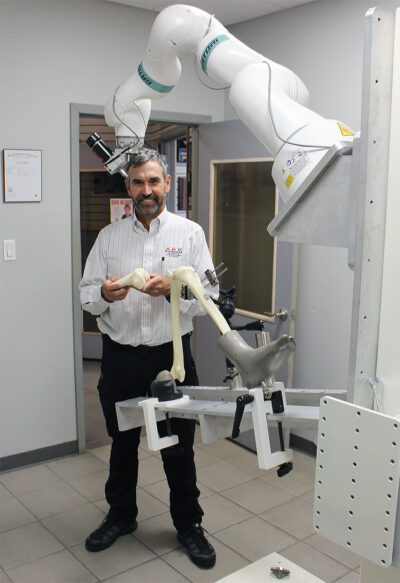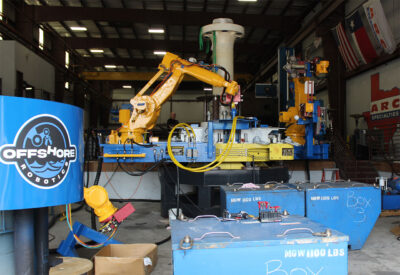
Dan Allford with surgery robot
The delicate touch required for surgery and the brute strength required to assemble miles of drilling pipe seem worlds apart. But both use advanced technology developed at a Houston company to advance the limits of what tasks robots can perform.
The company, ARC Specialties in the Spring Branch Management District, designs and manufactures robots and other automated systems to meet industrial challenges in the energy industry and beyond.
The company was recently recognized by robot manufacturer FANUC for using FANUC’s robots to improve the safety and efficiency of installing drilling riser, the pipe that connects a drilling ship to the ocean floor and which can be used as much as two miles below the surface.
Company founder and president Dan Allford said installing the riser required handling 70-foot sections of heavy flanged pipe, then connecting them using bolts that weigh up to 50 pounds that are torqued to as much as 18,000 foot-pounds — all from a floating drill ship that is never completely still.
Today’s workhorse robots aren’t the humanoid machines of science fiction. Many are variations of a single jointed arm that can move in six axes of motion or more, mimicking any reach of the human arm.
They come in a range of size and strength that far exceeds human arms, though, and can act with superhuman precision and repetition.
“We have little bitty ones that have one kilogram capacity and then we’re up to a couple with 1,000 kilogram capacity,” Allford said.
“When robots are born, they don’t even have a hand, and that’s kind of sad,” Allford quipped.
His company provides the “hands” for the robot, fitting them to the needs of customers in 33 countries and in industries as diverse as oil and gas, nuclear, medical and all kinds of manufacturing.
The tool at the end of the robot’s arm is called an end effector; the “hand” attached to the robot can be a welding torch, a drill, a cutting torch, a gripper or even a scalpel.
The latest patent for ARC Specialties, which employs 65 people, is for a robot that does surgery.
“When we’re in the surgical theater, the doctor needs to register that bone beneath the soft tissue,” Allford said. “So that means we have to probe at a specific pressure, so it requires that force feedback. We just got a patent on this and so that’s what we’re doing now is in order to be able to control the force the robot exerts. It has to have a sense of touch.”

Pipe assembly robots
Allford has set up a mock surgical suite where the robot can operate on 3D printed replicas of knees. Testing has not yet advanced to human patients, but the robot has completed successful knee surgery on a cadaver.
Some of the same advances that allow for knee surgery also allow for the heavy-duty work on drilling rigs, Allford said.
Advances in sensor technology that allow the robot to “see” and “touch” let it adapt to changing conditions, whether it’s human tissue that is slightly different from person to person, or riser pipe and bolts covered with seaweed, or picking apples that aren’t all exactly the same shape and size.
“So we’re no longer limited to stuff which was on Henry Ford’s assembly line, where every part was the same, and the placement was always the same. And this is what’s going to make robots powerful in the future is the ability to adapt to their environment.”
They’re no longer bolted to the factory floor, he said, but can increasingly go where needed.
While ARC Specialties builds equipment—often massive equipment—Allford said it is really in the software business, designing programs that can use existing or new technology to solve problems for businesses, doing the kind of work that robots do best: anything that is dull, dangerous or dirty. “What do they all have in common? It’s motion control and an industrial problem.”
The advances driving progress, he said, aren’t so much in the robots themselves as in better sensors, faster processing speed, and the ability to communicate information faster.
For all of these, the energy industry is driving innovation that can be applied to almost any sector, making Houston, and particularly the Energy Corridor, an ideal place to be for such work.
The airports and seaport that give convenient worldwide access to markets are just part of the equation.
“In Houston, we’ve got amazing colleges and tech schools. We’ve got U of H, you’ve got Rice,” he said. “You have a business-friendly environment. Name a better place for a robot guy to be.”
See robotics videos and more at https://www.arcspecialties.com/
— by Mark Fleming





